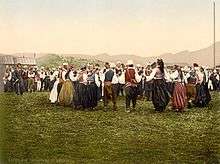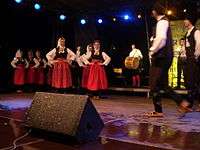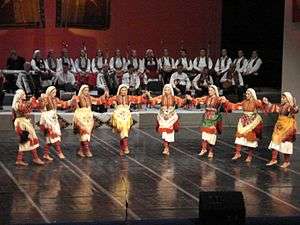Kolo (dance)

Kolo or Oro (Bosnian: Коло, Kolo, Croatian: Kolo, Serbian: Коло, Kolo Belarusian: Кола, Kola, Macedonian: Оро, Oro, Slovene: kolo) is a collective folk dance common in various South Slavic regions, named after the circle formed by the dancers.
Description
The Kolo, or Oro, is danced primarily by people from Bosnia and Herzegovina, Bulgaria, Croatia, Macedonia, Montenegro, Serbia and Bela krajina region of Slovenia. It is performed amongst groups of people (usually several dozen, at the very least three) holding each other's having their hands around each other's waists (ideally in a circle, hence the name). There is almost no movement above the waist. The basic steps are easy to learn, but experienced dancers dance kolo with great virtuosity due to different ornamental elements they add, such as syncopated steps. Each region has at least one unique kolo; it is difficult to master the dance and even most experienced dancers cannot master all of them.
The dance is accompanied by traditional instrumental music (bearing the same name), performed most often with an accordion, but also with other instruments: frula (traditional kind of a recorder), tamburica, or šargija.
Many variations of Kolo are normally performed at weddings, social, cultural, and religious ceremonies.[1] Kolo may be performed in a closed circle, a single chain or in two parallel lines. Both men and women dance together, however some dances require only men to dance and some dances are only for women. The music is generally fast paced and contains tricky steps.[2] Kolo costumes vary from region to region, but Bosnian and Serbian dance costumes typically are the most similar to each other. Men wear a cap, loose blouse tucked in to trousers that balloon around the thighs and then tightening from the knee down to the ankle. Women wear long white embroidered dresses with very heavy velvet aprons tied at the waist. Both the dress and apron are embroidered with bright flowers to enhance the females outfit. Generally, both men and women wear embroidered velvet vests. One of the most interesting components of the kolo costume are the shoes. The shoes are called Opanci which are made from cured pig skin that is molded to fit the dancers foot.[3]
The dance was used by Antonín Dvořák in his Slavonic Dances - The Serbian Kolo is the seventh dance from opus 72.
Gallery
-

Croatian dance from Dubrovnik
-

Group dancing "Vranjsko polje" (from Vranje) in Caransebeş, Romania
-

A Macedonian dance ensemble
-

The Southern Slavic Dance Ensemble perform in Budapest
National varieties
See also
| Wikimedia Commons has media related to Kolo (dance). |
- Hora (dance)
- Circle dance
- Assyrian folk dance
- Kurdish dance
- Armenian dance
- Turkish dance
- Faroese dance
References
- ↑ kolo. (2009). In Encyclopædia Britannica. Retrieved March 26, 2009, from Encyclopædia Britannica Online: http://www.britannica.com/EBchecked/topic/321451/kolo
- ↑ kolo. (2009). In Encyclopædia Britannica. Retrieved March 26, 2009, from Encyclopædia Britannica Online: http://www.britannica.com/EBchecked/topic/321451/kolo
- ↑ Costumes. (2009). In ASKA Kolo Ansambl. Retrieved March 26, 2009, from ASKA Kolo Ansambl http://www.ndidenko.net/askakolo/folklore/costumes.htm